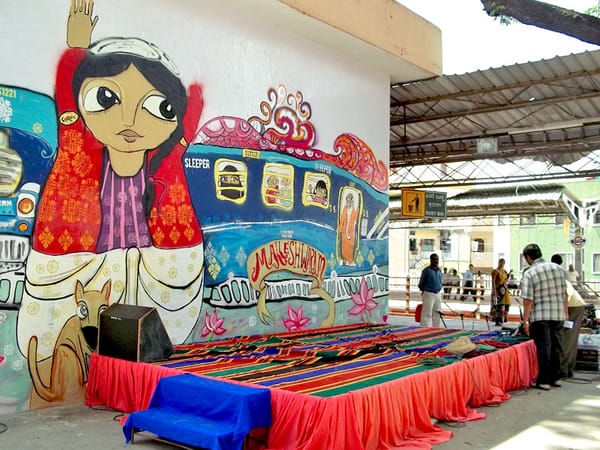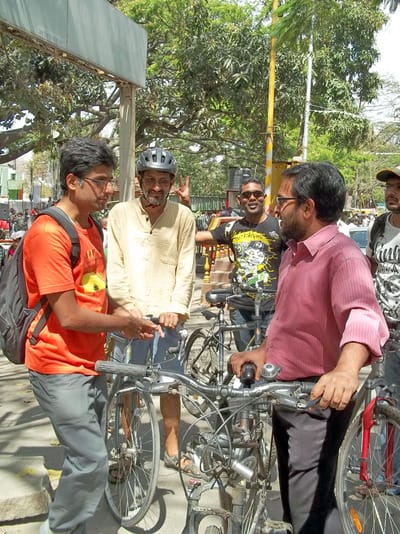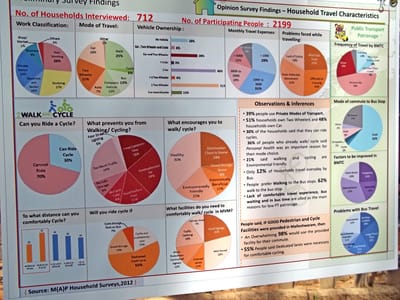The traffic near the erstwhile High ground Police Station refused to move. It was already eleven in the morning and I had set up an appointment to meet Archana Prasad, Jaaga’s founder, at 11.30. As the clock ticked away, I couldn’t help but smile at the tailormade situation for the topic I was to discuss with her.

Art by Indo-German artists. Pic: Poornima Dasharathi
The Directorate of Urban Land Transport(DULT) had partnered with Jaaga to explore alternate non-motorized transport solutions for Malleswaram. The project named "Malleswaram Accessibility Project" had an objective surveying the existing modes of transport and the commuting problems of local people and use such data to improve the existing infrastructure.
Apart from being a cultural hub, Malleswaram brings to one’s mind the traffic one has to crawl through on Sampige and other roads. DULT had an ambitious project of creating a environmentally conscious pedestrian and bicycle friendly locality here and had partnered with Jaaga.
Jaaga helped in coordination with several like minded individuals and organisations and collected over 1800 surveys that spanned across residents, workers, students and just visitors to the area. These survey provided Jaaga volunteers with information on occupations, modes of transport, work hours and vital suggestions.
Excerpts from the Interview.
How did it all start and why Malleswaram?
As a part of BCP, when Krupa & I created Neighbourhood Diaries for Whitefield, we always had in mind that we should do something like it for Malleswaram, a place where I was born and brought up. Around 2009/10, I had a chat with Murali, a friend who was at that time executing a cycle tracks project in Jayanagar. I told him I could help with the social and cultural inputs if he wanted to do something similar in Malleswaram.
Murali took me to meet Manjula Madam(DULT Commisioner) and she was quite enthused of the whole project.
Malleswaram has high density traffic since it also links many areas to North Bangalore. Is there any plans to study this aspect and provide an alternative?
No. See the whole point was limited to creating a more bicycle and pedestrian friendly tracks in Malleswaram. We know that cycling in Sampige road is pointless. So we surveyed across the whole suburb to explore the possibilities of creating non-motorized transport and pedestrian friendly walkways.
How did Jaaga help in the whole project?

Malleshwaram on a cycle. Pic: Poornima Dasharathi
Our strengths are community engagement, creating awareness of neighbourhood heritage and documentation. Such surveys are usually handed to an agency who send people out to the streets with the task of completing x number of forms. I wanted to do it differently.
So initially we hosted large gatherings and discussed about the survey so that people are aware of such a project. We included a socio-cultural section to the survey that will be analysed at the end of the project.
We coordinated with associations, schools; in fact we trained around 25 sociology students from MES College and this became a part of their curriculum. These students collected a large part of the data.
We also conducted activites with Vivekananda College students that was not core data but other information such as roadside surveys and traffic density.
Any other organisations, individuals?
We were also supported by Max Mueller. As you know we have Indo-German artists who have worked on four buses that are placed in strategic places in Malleswaram and also on public walls.
We have also created artist portraits. You can find videos of Abhijeet Tambe, Geetha and Gopal Navale and Vasundhara Das. Incidentally Vasundara’s first music performance was in one of the jams that the Navale couple used to conduct for budding musicians. You can find these videos on our website.
Will Jaaga be involved in more such projects?
In the future projects, we(Jaaga) will help in bringing together individuals and organisations who work in that space with the Government, work more in the background.
The event
On 25 February, the project was showcased to the public. The event schedule stated that the inauguration was at Malleswaram Railway Station.

Survey data analysis. Pic: Poornima Dasharathi
On this day too, I had to walk down the 11th main from 15th cross towards the Malleswaram Railway Station as there was long traffic pile up behind slow moving garbage truck. Somehow I was dogged by traffic jams through out my interactions with the project.
At the station, the Malleswaram MLA, Aswath Narayan, gave an informal talk as he lauded the project. The Director of MaxMueller, Christoph Bertrans, who followed next appreciated the efforts and thanked the Indo-German artists who had created a wonderful painting on the station wall that served as a colourful backdrop to the dias.
STEM Dance Kampani gave a beautiful performance that was inspired by martial dances such as Kalaripayattu. Soon it was time for the walks based on Art & Culture and Heritage – a combination that Malleswaram is strongly identified with. The walks were led by Krupa and Pankaj of Saythu. While the art & culture tour was a walk along the 9th cross, the heritage theme was a cycle tour that started at St Peter’s seminary. Since I didn’t have a cycle, I chose the art & culture walk.
The Art & Culture Walk took us along the 9th cross where we could see the art work of some leading Urban Avant Garde artists like ECB Hendrik Beikirch, on public walls and the buses parked along this street.
One of the buses had sound bytes of conversations with old Malleswaram residents and the area of their times. DULT had also exhibited the results of their Survey along the route.
On the 9th cross we trudged towards the Ganesha Temple and the park next to it where it culminated. The cycle tour based on the heritage theme also joined us here. From a few conversation among the cyclists, I could see that they were quite impressed.
As I sat in this quiet pocket so incongruously next to a busy market, I mulled over the conversations of old Malleswaram residents. One of them had spoken about a time when Malleswaram’s vehicles were just cycles. Well, good news, DULT is trying to bring them back to the area.
⊕